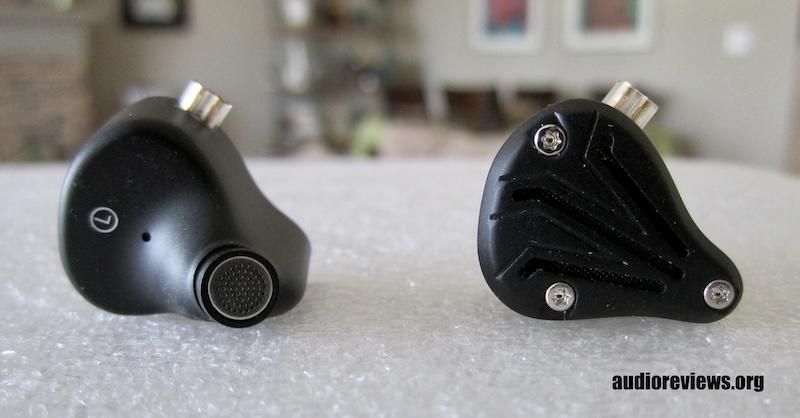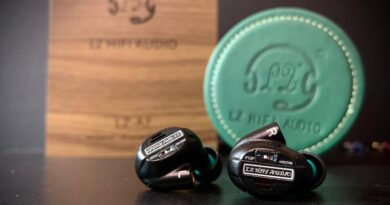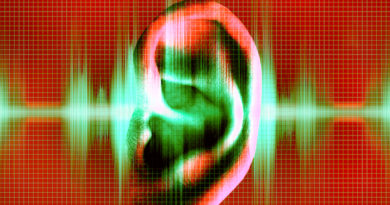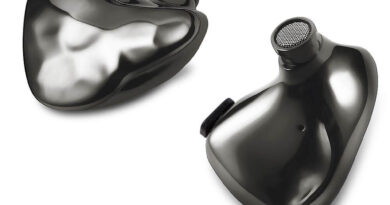TRN BAX Pro Review – Electroexstatic
The $410 TRN BAX Pro is the company’s 5-driver flagship that convinces by its slightly tempered, transparent, realistic sound. Yes it sounds really good. But it also confuses us with cumbersome switches and generic accessories.
PROS
- Great, natural sound with outstanding imaging and holographic stage
- Modular cable for single-ended and balanced circuits
CONS
- Unusual nozzle angle
- Tuning switches are overkill
- Generic design and accessories
In this Article
The TRN BAX PRO were provided my review by the manufacturer. I thank them for that and also apologize for the long delay of the publication of this article owing to some lengthy orofacial problems. You can get them from TRN Audio.
Introduction
TRN, or more precisely, Dongguan Zuodu Acoustics Technology Co., Ltd. are a ChiFi player of the first hour, from a time when a budget Chifi model reached easily 40,000 views on Head-Fi in a few weeks. Examples are the TRN V80 and V90.
TRN, like many other relatively inexperienced ChiFi companies (compared to, let’s say, the more established Sennheiser or Audio Technica), overestimated their abilities and prematurely released earphones in the premium segment that may have had the ingredients but the final meal was subpar. For example, the TRN BA8 was a screamer and unable to deliver musical enjoyment to the aided ear. And the original BAX was apparently not much better (I was told).
Time cures wounds and companies mature. TRN reassembled and tried again in order to close the reputation gap to, let’s say, Dunu or Moondrop.
Specifications TRN BAX PRO
| Driver Architecture: Quad-driver triple-hybrid Drivers: Beryllium diaphragm dynamic (bass) + Knowles 29689 BA (mid frequencies) + Knowles 33518 BA and Sonion Electrostatic (high frequencies) Impedance: 32 Ω Sensitivity: 114 dB/mW Frequency Range: 7-40,000 Hz Cable/Connectors: eight-strand single crystal copper/3.5+2.5+4.4mm modular/2pin 0.78 mm Tested at: $410 Product Page/Purchase Link: TRN Audio |
Physical Things and Usability
The BAX PRO features quality ingredients and an interesting architecture: 1 DD + 2 BA + 2 EST: a Beryllium diaphragm for the bass, 1 Knowles 29689 BA for the mid frequencies, and another Knowles BA 33518 as well as two Sonion electrostatic drivers for crisp treble. It also comes with a modular cable with 3.5 mm single ended and 2.5 mm & 4.4 mm balanced plugs.
In the box are the earpieces, 2 sets of eartips with three tuning switches, the modular cable with three plugs, a strange plaque, a small tool for moving the switches, the usual TRN metal storage box and the paperwork.
The CnC machined, sturdy earpieces are rather large and have a bit of an unusual nozzle angle. Some people complained about not getting them deep enough into their ear canals, I have had no issues. But I don’t get the world’s greatest isolation with them either.
The eight-strand single crystal copper cable is rather pliable and, appeal wise, average. The eartips (2 silicone sets and 1 foam set)) are also nothing to write home about. In summary, the BAX PRO’s haptic is ok.
The BAX PRO are easy to drive.
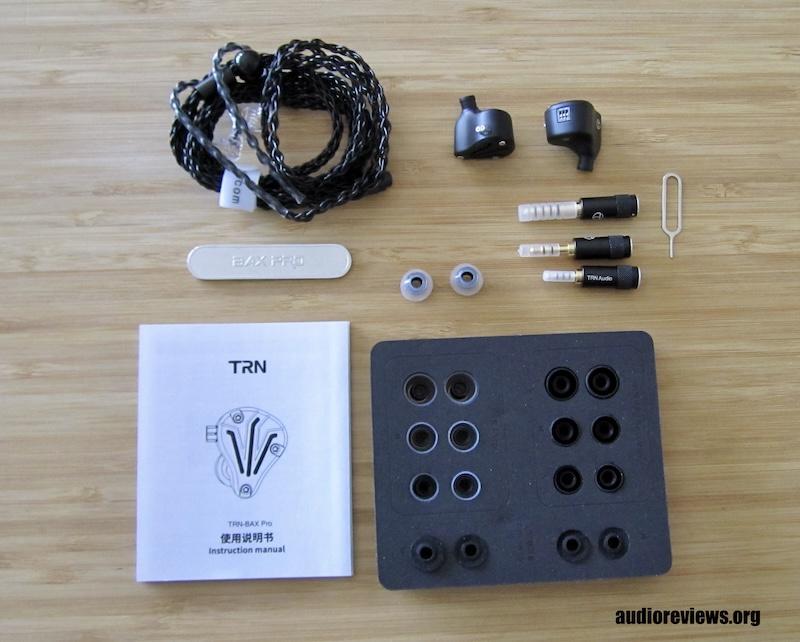
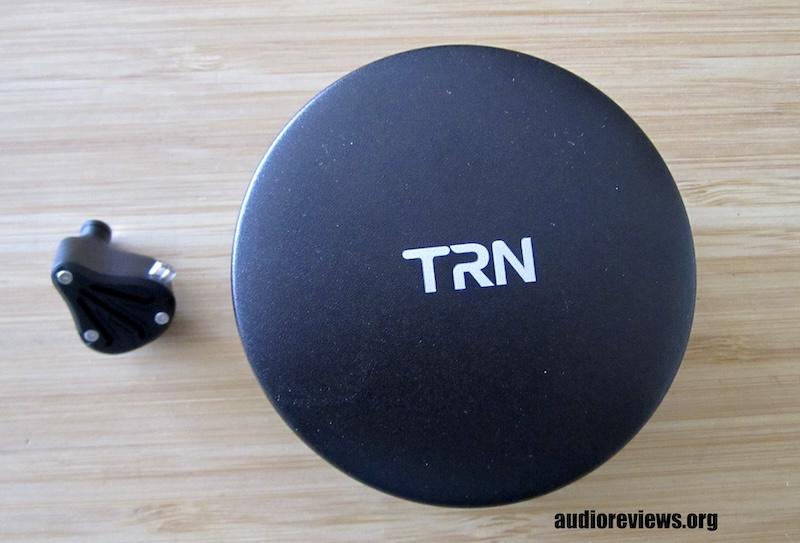
Tonality and Technicalities
| Equipment used: MacBook Air | iPhone SE (1st gen.), Questyle QP1R | EarMen Tradutto & CH-Amp, Earstudio HUD 100 (low gain), AudioQuest DragonFly Cobalt | black stock eartips. |
It is very difficult to give you an accurate account of the sound considering the options you have with switch positions and (stock) eartips. The BAX PRO are also sensitive to insertion depth so that different reviewers may report different results. Let me start with the black stock eartips and all switches in the “off” position [“Equalization mode”].
If you expect another TRN shoutfest, you may be surprised to hear that this is not the case. The BAX PRO offer a slightly warm however transparent sound with vocals in the foreground and zero shoutiness. I was quite delighted when I tried them out the first time and left them in my ears for a couple of hours going through a selection of jazz, rock, and classical.
What sticks out to me is the lower midrange: both female and male vocals are sparkly, very well sculptured in three dimensions, and rather intimate with a very good body. Bass is digging deep but is a bit subdued, thick, and could be a tad crisper while having enough kick…a bit similar to the Sennheiser HD 600 headphones…but you can tweak this with the switches, insertion depth and eartips. The midrange has good transparency and resolution without a hint of shoutiness. Very realistic.
TRN spent lots of attention on the treble – which are very well carved out with excellent resolution. My treble testing passed, for example, Anne Sophie Mutter’s rendering of the very high violin notes of her pieces from Star Wars. Cymbals are very clean…though rather subtle.
The technical merit of the BAX PRO is also very good. Stage may be average in two dimensions, but the spatial reprodcution and imaging are excellent. You really can spot the singer on stage. Dynamics is also good.
Timbre is also rather natural. I much preferred it over the glassy BA sound of the Blessing 2, allegedly the first $1000 soundalikes at $300. I listened to a lot of Beethoven piano music and orchestral pieces with great pleasure.
The piano touch was quite realistic and revealed a good driver speed. Timbre and dynamics paired result in orchestral sounding natural and developing a healthy richness and volume. Surprising how good the BAX PRO work with acoustic instruments of any quantity.
I confirmed my positive listening impressions when connecting the BAX PRO to the EarMen stack after listening to the Sennheiser HD 600. They did hold up to my big surprise.
Let’s have a look at the switch settings.
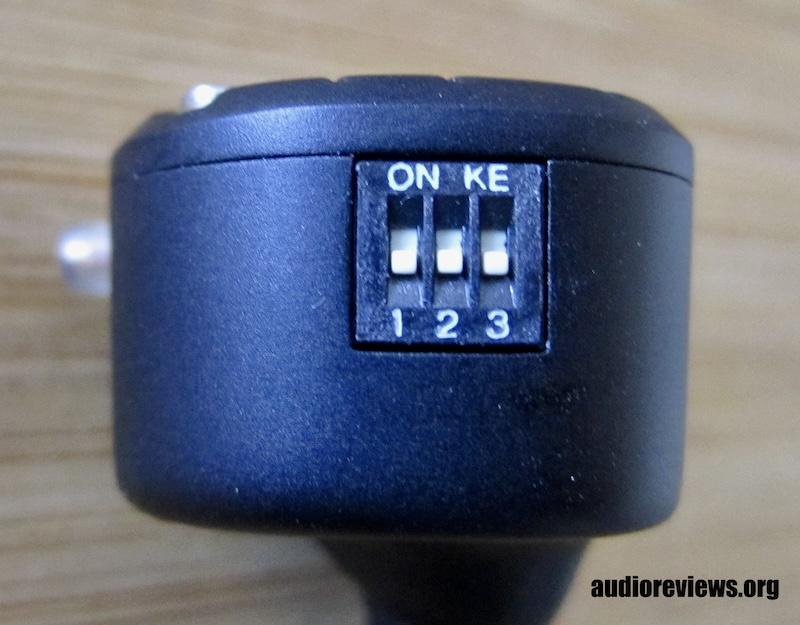
Equalization
The standard mode which sounds best to my ears. I use this mode as comparison to the other switch settings.

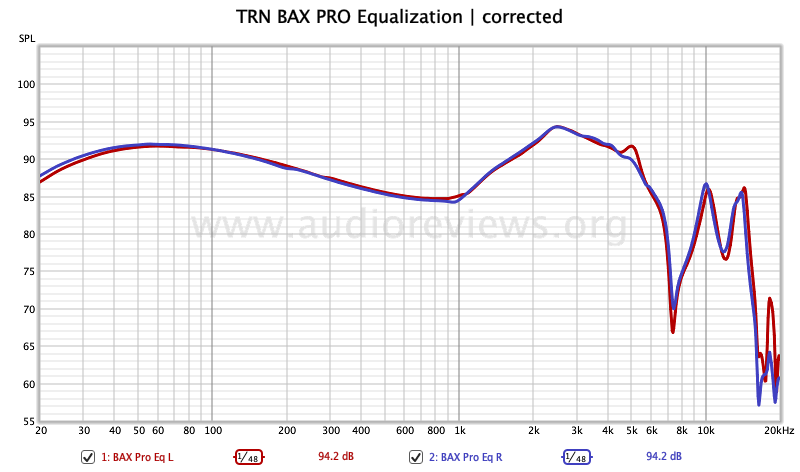
Electronic Mode
Enhances the upper midrange and introduces shoutiness. Not for me.
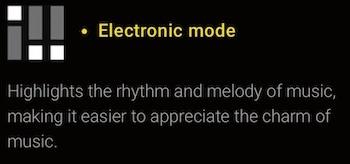
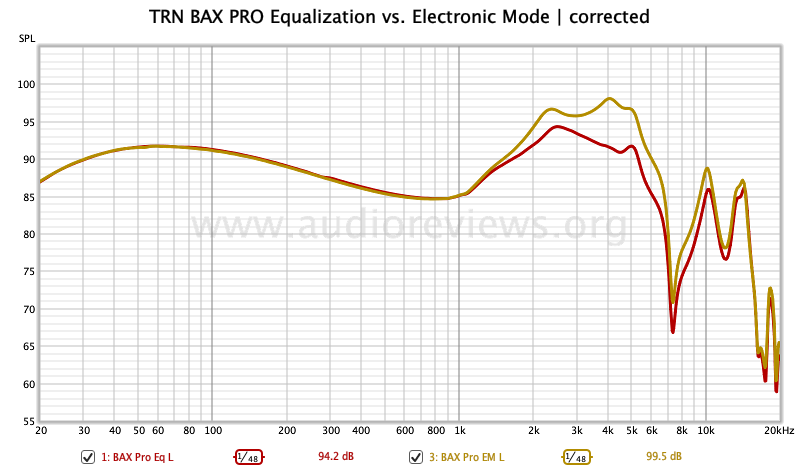
Transparency Mode
Bass imbalance 2-3 dB. Reduces bass and adds upper midrange. Introduces even more shoutiness than Electronic mode. Transparency is good enough without this mode.
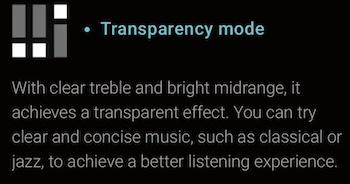
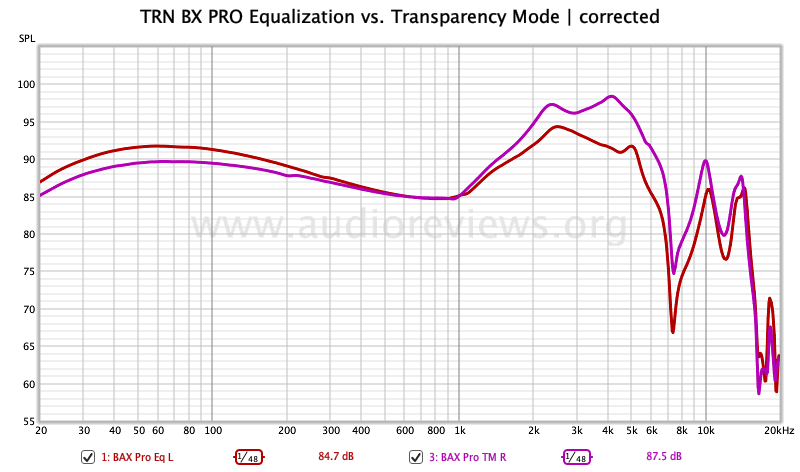
Atmospheric Enhancement
Is the same as Electronic Mode in my measurements…I did two independent measurement runs to confirm.
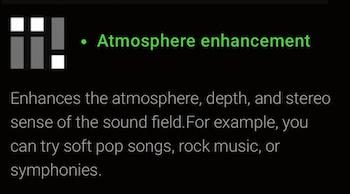
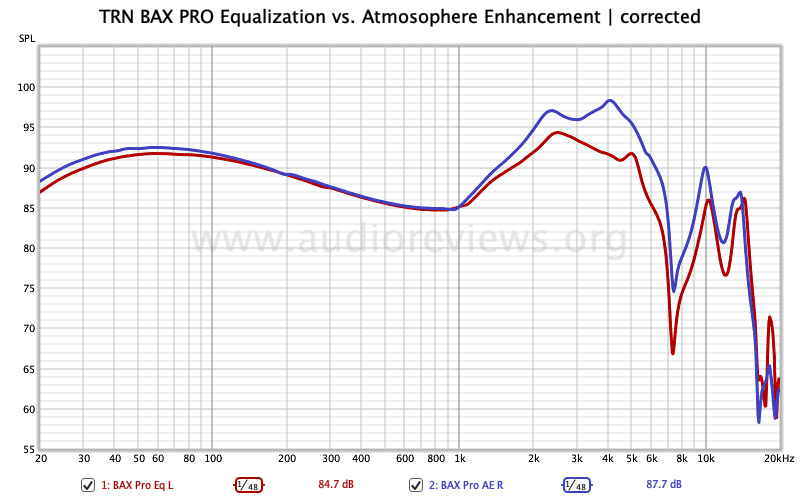
High-Frequency Mode
Adds to upper midrange and to treble. Only for the hardest of us who get up with cheap Bourbon whiskey in the morning. Too bright for the rest of us.
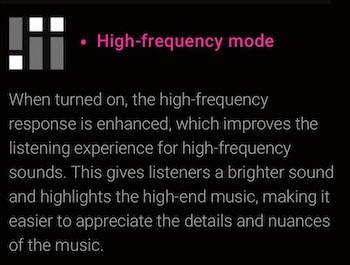
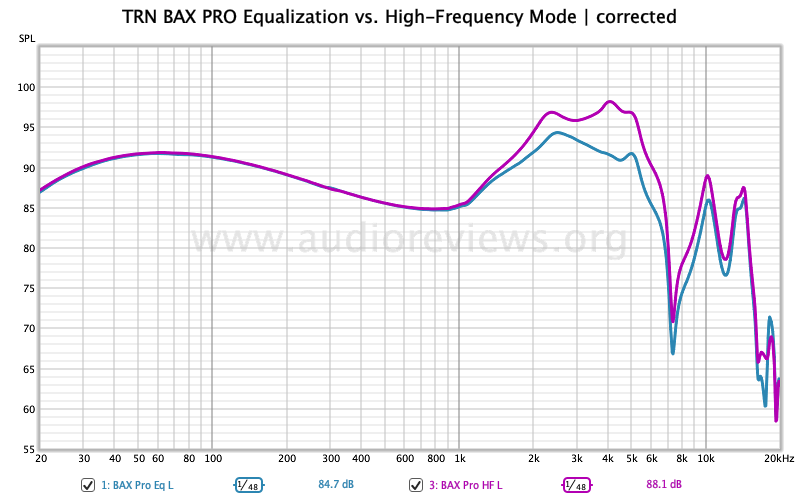
Low Frequency Mode
Essentially the same as Equalization, with the upper midrange minimally tuned down. Good.
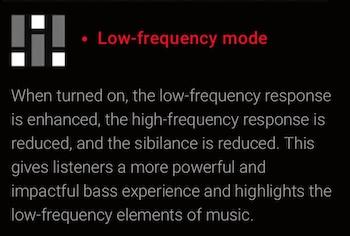
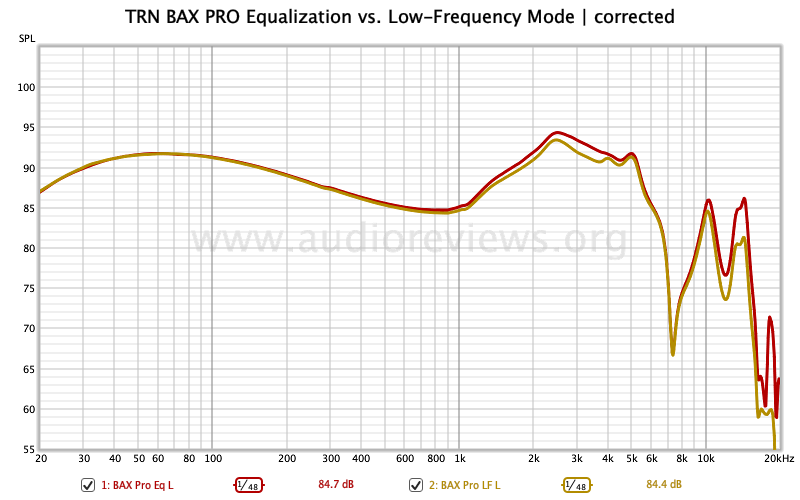
Compared to the LETSHUOER EJ07M
The EJ07M have been one of my daily drivers for the last couple of years. They also sport electrostatic tweeters and are, at $649, ca. 50% more expensive than the BAX PRO. They feature smaller earpieces with a different nozzle angle, which probably provide a better fit for many. Their imaging is flatter than that of the BAX PRO (in the Equalization setting), they are generally a tad brighter sounding and more coherent overall.
The BAX PRO have the upper midrange dialled down (in the Equalization setting), which makes the vocals thicker but also duller and less dynamic. In terms of treble resolution, both are pretty even, with he BAX PRO possibly a tad ahead. I’d like the EJ07M’s form factor with the BAX PRO’s sound.
Overall, the price difference appears arbitrary.
Concluding Remarks
The TRN BAX PRO come as a very pleasant surprise to me. They sound enjoyable to my ears with all musical genres I threw at them. The money is essentially in the excellent holographic staging and imaging. But I am also confused: the switches are not very useful as most of the settings only add shrillness nobody needs. Sometimes, less is more!
My other criticism is the very generic accessories (cable, eartips). And some may have problems with the fit owing to the unusual nozzle angle. Sometimes, more is better!
In the end, I recommend trying them out if possible. I may have to send them on a western Canadian tour to gather some feedback from Biodegraded and Co. We may have a diamond in the rough that is overlooked owing to lack of concerted promotion and organized hype.
TRN are finally on their way to join the likes of Moondrop and Dunu in the mid tier segment (if they leave useless gimmicks such as switches off). They now have to substantiate this with other models. Durwood is currently taking on their Dragon Azure, and I am anxious to see what he will come up with.
Until next time…keep on listening!




